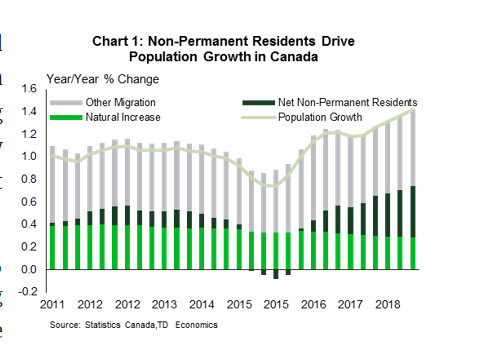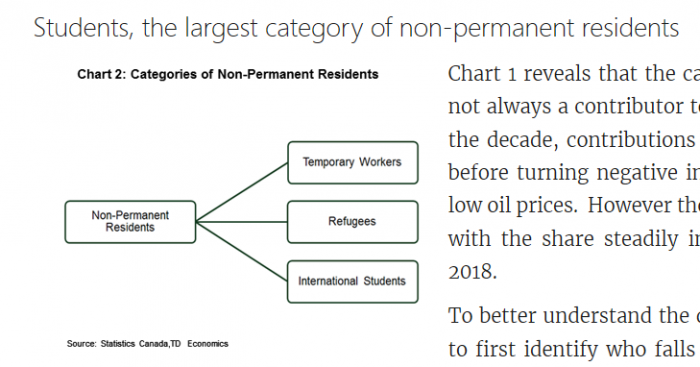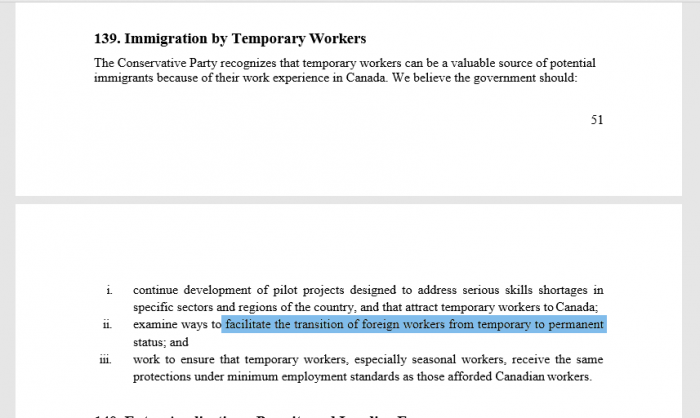(TD Canada Bank releases article on Canada’s population boom)

(Population growth in Canada)

(So-called “non-permanent” groups in Canada)

(Groups of “non-permanent” once more)

(Conservative Party of Canada on turning “temps” into PR)

1. Mass LEGAL Immigration In Canada
Despite what many think, LEGAL immigration into Canada is actually a much larger threat than illegal aliens, given the true scale of the replacement that is happening. What was founded as a European (British) colony is becoming unrecognizable due to forced demographic changes. There are also social, economic, environmental and voting changes to consider. See this Canadian series, and the UN programs for more detail. Politicians, the media, and so-called “experts” have no interest in coming clean on this.
CLICK HERE, for UN Genocide Prevention/Punishment Convention.
CLICK HERE, for Barcelona Declaration & Kalergi Plan.
CLICK HERE, for UN Kalergi Plan (population replacement).
CLICK HERE, for UN replacement efforts since 1974.
CLICK HERE, for tracing steps of UN replacement agenda.
Note: If there are errors in calculating the totals, please speak up. Information is of no use to the public if it isn’t accurate.
2. Important Links
CLICK HERE, for the TD Canada article.
http://archive.is/N9wpP
CLICK HERE, for mass migration at 1M/year in Canada.
CLICK HERE, for migration programs in Canada.
CLICK HERE, for replacement migration since 2003/04.
CLICK HERE, for domestic violence path to permanent residence.
CLICK HERE, for International Mobility Program.
CLICK HERE, for remittances and brain drain.
CLICK HERE, for economic migration during high unemployment.
CLICK HERE, for CANZUK review.
3. Annual Immigration Reports To Parliament
2004 Annual Report to Parliament
2005 Annual Report to Parliament
2006 Annual Report to Parliament
2007 Annual Report to Parliament
2008 Annual Report to Parliament
2009 Annual Report to Parliament
2010 Annual Report to Parliament
2011 Annual Report to Parliament
2012 Annual Report to Parliament
2013 Annual Report to Parliament
2014 Annual Report to Parliament
2015 Annual Report to Parliament
2016 Annual Report to Parliament
2017 Annual Report to Parliament
2018 Annual Report to Parliament
Archived listings of Reports
4. Some Context For This Review
It has been covered many times on this website, but the public is being grossly mislead about the true size and scale of mass migration in Canada.
Here is an article from Toronto Dominion Bank, essentially confirming all of the facts, but otherwise justifying the practice.
5. Quotes From The Article
Students, the largest category of non-permanent residents
To better understand the drivers of this recent trend, it is useful to first identify who falls under the banner of non-permanent residents. A non-permanent resident is a non-Canadian who is legally authorized to enter and reside in Canada for temporary purposes. Statistics Canada breaks down non-permanent residents into three categories: temporary workers, refugees, and international students (Chart 2).
But as we will see “non-permanent” doesn’t really mean non-permanent. There are a great many pathways to keep people staying longer and longer.
First, temporary workers are those who have been permitted to work in Canada under two main programs: the Temporary Foreign Workers Program (TFWP) or the International Mobility Program (IMP). Applicants may also obtain work permits for other purposes, which include humanitarian and compassionate reasons.
Exactly. You can obtain different visas or work permits later.
The TFWP aims to fill gaps in the labour market that arise when there are no available Canadians to carry out responsibilities of a job. To establish this need, an employer must undergo a Labour Market Impact Assessment (LMIA). On the other hand, applicants to the IMP are not required to complete a LMIA as its purpose is to fulfill Canada’s larger economic and cultural goals. For example, the IMP serves Canada’s major trade agreements such the North American Free Trade Agreement (NAFTA) and Canada’s reciprocal exchange agreements. It also awards post-graduation work permits to eligible international student graduates which allows them to gain Canadian work experience and fill labour market needs.
For some clarification: in 2014 the TFWP was broken up. Now there are two separate programs. (a) The Temporary Foreign Worker Program is supposed to a specific labour shortage fulfillment, while (b) International Mobility Program is essentially an open work permit.
Also, please note that BOTH programs generally allow for extensions. BOTH are pathways towards permanent residency, and eventual citizenship.
Chart 3 shows how net inflows of TFW have stacked up relative to other non-permanent residents over the past decade. (Given data limitations, we used IRCC source data to infer trends of the various components.) The TFW category has been dropping in recent years since reaching a peak in 2013. This development can be explained by reported abuses of the program, which prompted efforts by the federal government to tighten the qualifying criteria.
Again, these aren’t really “non-permanent”, regardless of how the program is described. There absolutely are options for many people to remain in Canada.
6. Why Are Refugees “Non-Permanent”?
Next, refugees are those who request protection upon or after arrival to Canada. This has historically been the smallest category of non-permanent residents.
Finally, the last and largest category is international students. These are people who are permitted to study in Canada in any program of their choice.
Many refugees annually become “protected persons”. Then they can remain in Canada forever. This absolutely is permanent migration for most successful people.
7. Transitioning Students Into Permanent Residents
Second, as more and more international students’ transition from non-permanent resident status to permanent resident status, they support long-term prosperity of the Canadian economy. Specifically, they help ease demographic pressures, provide a potential boost to productivity and promote diversity in Canada. Indeed, recent data suggest that not only is the share of students on study permits increasing, but so too are retention rates upon completion of PSE and temporary work permits (Chart 9). In a 2018 survey conducted by the Canadian Bureau of International Education, around 60% of respondents stated that they intended to apply for permanent resident status in Canada, up from 51% in 2015.
Why are students considered temporary? By their own admissions, according to this survey, a majority intend to apply to become permanent residents.
8. Final Thoughts
On some level, it is nice to have some confirmation about what has been written about here for a while. Namely, that mass migration into Canada is far higher than what the public thinks.
However, the article ignores several realities. What about the increasing balkanization of Canada along racial, cultural, ethnic, linguistic lines? How will we ensure compatibility of people coming? How will we do proper screening? How will be maintain the cultural makeup that formed Canada in the first place?
Canada first, anyone?
